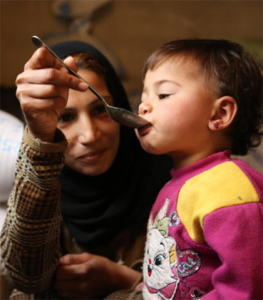Syrian crisis worsening
After 11 years of war, upheaval and displacement, Syrians are facing the worst humanitarian conditions since the start of the crisis, with food shortages and rising prices for fuel and basic necessities.
A new report from the World Food Program (WFP) says a record number of Syrians – 12.4 million out of an estimated population of 17.5 million – now face food insecurity.
 In the last year 4.5 million more Syrians have seen life become more precarious.
In the last year 4.5 million more Syrians have seen life become more precarious.
The reports says the worsening situation has been the result of a number of factors, including an economic slide worsened by COVID-19, neighbouring Lebanon’s financial meltdown and the impact of US sanctions.
“This conflict has taken a tremendous toll on the Syrian people. Every day more and more Syrians are pushed deep into hunger and poverty,” the WFP report says.
“Syrians are facing multiple shocks, including the collapse of the Syrian pound, its impact on the price of basic commodities, the fall-out from the financial crisis in Lebanon, as well as the ongoing hostilities and large-scale displacement. The Covid-19 pandemic has further exacerbated the food security situation,” it says.
WFP Representative and Country Director in Syria Sean O’Brien said: “Families are faced with impossible choices: do they put food on the table, or get the healthcare they need? Or can they send their children to school? Without sustained assistance, these families simply cannot survive.”
Food prices have increased by more than 200 per cent in the last year. Families report that, even during the worst years of conflict, life was never as hard as it is now. Parents say they have not eaten meat and fruit for months as prices of staple foods have soared beyond reach, the report reveals.
Almost five 5 million people are receiving food assistance from the UN inside as well as 1.5 million more Syrian refugees in neighbouring Turkey, Lebanon, Jordan, Iraq and Egypt.
These five countries host more than 5.6 million Syrians, the biggest refugee group in the world.
Across the region, progress made over the last ten years to improve food security is in decline, with the number of Syrian refugee families living under the extreme poverty line rising to a staggering 89 percent in 2020, up from 55 per cent only a year before.
The economic collapse is often referred to as a “bread crisis” due to the long queues outside bakeries that appeared in late 2020 as the Syrian pound (SYP) began to fall.
This sparked anger and there were occasional protests in government-controlled areas – rare events given the tight control the security forces have on much of the population.
But the financial and food crisis has hit Syrians across the country in different ways and levels of intensity because of the way the country is split.
The northwest, around Idlib province, is run by rebels; the northeast is governed by a Kurdish-led administration, with the presence of al-Assad, US, and Russian forces in some locations, plus pockets of Turkish control.
Each part of the country has access to different markets, borders, natural resources, and sources of aid.
Also, adding to the complicated picture is the fact that the rebel-held northwest moved to using Turkish currency last northern summer, in a bid to avoid the impacts of the Syrian pound’s runaway inflation.
At the start of Syria’s war, one US dollar bought 46 Syrian pounds. In January 2020, it fetched 940 and in July 2021, it’s at 3,220, down from a peak of almost 4,000 in March.
The price of flour is highest in the capital city of Damascus, an al-Assad stronghold.
While Syria has long grown its own wheat, its capacity to do so has been severely damaged by the war, as farmers were forced to flee and farmlands were destroyed in fighting.
Also, drought has contributed to decreased production, even in north-eastern Hassakeh province, typically known as the country’s “breadbasket”.
The Kurdish administration that runs Hassakeh sells wheat to the al-Assad government, but the government has also been increasingly forced to rely on imports.
This has become harder as businesspeople struggle to access their money in Lebanon, which is suffering through its own crippling economic disintegration.
In government-held parts of Syria like Damascus, Aleppo, and Hama, residents are entitled to buy a limited amount of bread at subsidised bakeries. But wheat shortages have led the government to double the price recently, and those who can afford it look to private bakeries and shops for their bread.
Read the WFP report here: https://www.wfp.org/news/ten-years-war-ravaged-syrians-grapple-their-worst-hunger-crisis-yet












